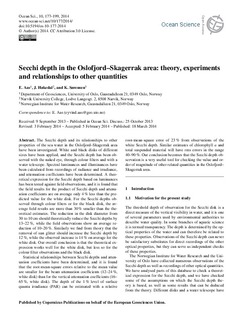| dc.contributor.author | Aas, Eyvind | |
| dc.contributor.author | Høkedal, Jo | |
| dc.contributor.author | Sørensen, Kai | |
| dc.date.accessioned | 2014-10-22T12:32:55Z | |
| dc.date.accessioned | 2014-11-21T12:21:21Z | |
| dc.date.available | 2014-10-22T12:32:55Z | |
| dc.date.available | 2014-11-21T12:21:21Z | |
| dc.date.issued | 2014 | |
| dc.identifier.citation | Aas, E., Høkedal, J. and Sørensen, K., 2014. Secchi depth in the Oslofjord–Skagerrak area: theory, experiments and relationships to other quantities. Ocean Science 10(2) 177-199. | nb_NO |
| dc.identifier.issn | 1812-0784 | |
| dc.identifier.uri | http://hdl.handle.net/11250/226288 | |
| dc.description.abstract | The Secchi depth and its relationships to other properties of the sea water in the Oslofjord–Skagerrak area have been investigated. White and black disks of different sizes have been applied, and the Secchi depth has been observed with the naked eye, through colour filters and with a water telescope. Spectral luminances and illuminances have been calculated from recordings of radiance and irradiance, and attenuation coefficients have been determined. A theoretical expression for the Secchi depth based on luminances has been tested against field observations, and it is found that the field results for the product of Secchi depth and attenuation coefficients are on average only 4% less than the predicted value for the white disk. For the Secchi depths observed through colour filters or for the black disk, the average field results are more than 30% smaller than the theoretical estimates. The reduction in the disk diameter from 30 to 10 cm should theoretically reduce the Secchi depths by 13–22%, while the field observations show an average reduction of 10–20%. Similarly we find from theory that the removal of sun glitter should increase the Secchi depth by 12%, while the observed increase is 14% on average for the white disk. Our overall conclusion is that the theoretical expression works well for the white disk, but less so for the colour filter observations and the black disk.
Statistical relationships between Secchi depths and attenuation coefficients have been determined, and it is found that the root-mean-square errors relative to the mean value are smaller for the beam attenuation coefficients (12–24%, white disk) than for the vertical attenuation coefficients (16–65%, white disk). The depth of the 1% level of surface quanta irradiance (PAR) can be estimated with a relative root-mean-square error of 23% from observations of the white Secchi depth. Similar estimates of chlorophyll a and total suspended material will have rms errors in the range 40–90%. Our conclusion becomes that the Secchi depth observation is a very useful tool for checking the value and order of magnitude of other related quantities in the Oslofjord–Skagerrak area. | nb_NO |
| dc.language.iso | eng | nb_NO |
| dc.publisher | European Geosciences Union | nb_NO |
| dc.relation.uri | http://www.ocean-sci-discuss.net/10/1833/2013/osd-10-1833-2013.html | |
| dc.rights | Creative Commons Attribution License 3.0 | * |
| dc.rights.uri | https://creativecommons.org/licenses/by/3.0/ | * |
| dc.rights.uri | http://www.ocean-science.net/general_information/license_and_copyright.html | |
| dc.title | Secchi depth in the Oslofjord-Skagerrak area: theory, experiments and relationships to other quantities | nb_NO |
| dc.type | Journal article | nb_NO |
| dc.type | Peer reviewed | nb_NO |
| dc.date.updated | 2014-10-22T12:32:55Z | |
| dc.rights.holder | © Author(s) 2014 | |
| dc.subject.nsi | VDP::Mathematics and natural science: 400::Geosciences: 450 | nb_NO |
| dc.source.journal | Ocean Science | nb_NO |
| dc.identifier.doi | 10.5194/os-10-177-2014 | |
| dc.identifier.cristin | 1126287 | |

